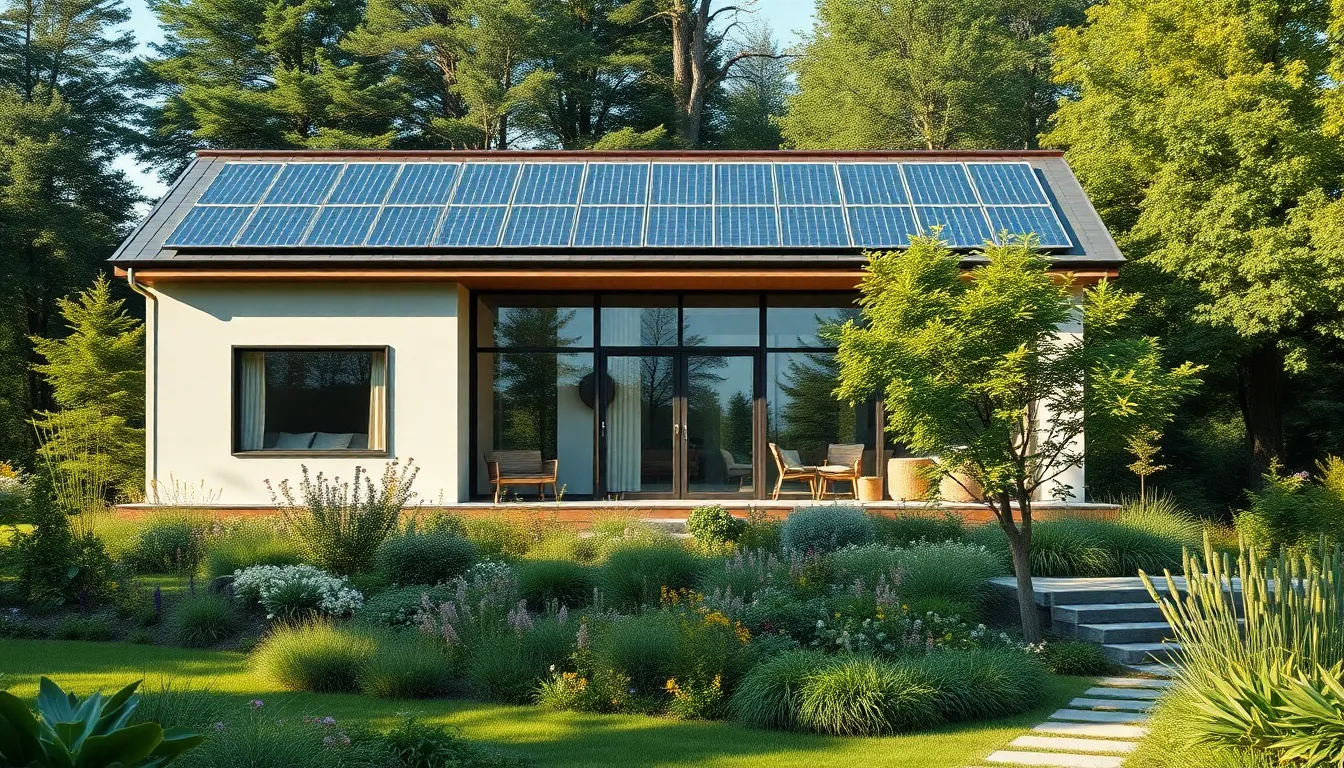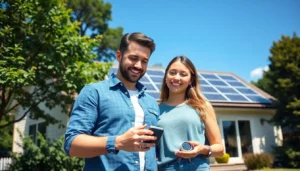Table of Contents
ToggleImagine living in a home that not only powers itself but also sends energy back to the grid, all while keeping your utility bills as low as your neighbor’s Wi-Fi signal. Welcome to the world of net zero energy homes, where energy efficiency meets eco-friendly living. These homes are designed to produce as much energy as they consume, making them the superheroes of sustainable living.
Overview of Net Zero Energy Homes
Net zero energy homes generate the same amount of energy they consume over a year. These homes utilize renewable energy sources, such as solar panels or wind turbines, to produce electricity. Energy efficiency plays a crucial role, as design elements like proper insulation and energy-efficient appliances minimize energy consumption.
Sustainable building materials contribute to the eco-friendly nature of these homes. They often incorporate recyclable or renewable resources, reducing environmental impact. Advanced technologies further enhance performance, allowing homeowners to monitor energy use in real time.
The financial benefits attract many homeowners. Net zero energy homes significantly lower utility bills, making them a cost-effective option long-term. Excess energy production can lead to credits or payments from energy companies, enhancing financial incentives.
Community impact remains significant as well. These homes contribute to a more resilient grid by supplying renewable energy to the surrounding area. Many local governments support net zero initiatives, recognizing their role in reducing overall carbon footprints.
Design flexibility allows homeowners to tailor solutions to individual needs. Different architectural styles and innovative designs can seamlessly integrate renewable technologies. Homebuyers increasingly seek these features, enhancing market value.
Numerous organizations promote net zero energy standards. The International Energy Agency and U.S. Department of Energy provide resources and guidelines. These frameworks encourage adoption, shaping building codes to prioritize energy-efficient practices.
Overall, net zero energy homes play an essential part in the transition to sustainable living. They balance energy consumption with renewable production, paving the way for a greener future.
Benefits of Net Zero Energy Homes
Net zero energy homes provide various advantages that contribute to environmental sustainability and economic efficiency. Their design incorporates innovative energy-saving technologies, promoting cleaner living.
Environmental Impact
Net zero energy homes significantly reduce greenhouse gas emissions. By relying on renewable energy sources, they decrease reliance on fossil fuels and lower the carbon footprint. Their construction often includes sustainable materials that minimize resource depletion. Additionally, these homes promote biodiversity through ecological landscaping, supporting local wildlife habitats. Energy-efficient features enhance climate resilience, decreasing vulnerability to extreme weather events.
Economic Savings
Economic savings become apparent through reduced utility costs. Homeowners can save up to 90% on energy bills, leading to substantial annual savings. Net zero energy homes increase property values, appealing to eco-conscious buyers. Financial incentives from various government programs often lower initial investment costs. Furthermore, rewarding returns come from selling excess energy back to the grid, making these homes a sensible financial choice over time.
Key Features of Net Zero Energy Homes
Net zero energy homes boast essential characteristics that enable them to achieve energy balance over the year. These homes integrate specific design elements to optimize energy use and production.
Energy Efficiency
Energy efficiency stands at the core of net zero energy homes. High-quality insulation minimizes heat loss during colder months and reduces cooling demands in the summer. Energy-efficient windows limit thermal transfer and enhance comfort. Appliances and lighting carry the ENERGY STAR label, operating at lower energy levels without sacrificing performance. Smart home systems manage energy consumption by automating heating, cooling, and lighting based on real-time needs. Utilizing passive solar design principles further enhances efficiency, allowing sunlight to contribute to heating and lighting. These strategies collectively lead to substantial energy savings, making energy bills significantly lower.
Renewable Energy Sources
Renewable energy sources power net zero energy homes. Solar panels often cover rooftops allowing homeowners to harness sunlight and convert it into electricity. Wind turbines may also supplement energy production in some locations, providing additional renewable power. Geothermal systems utilize the earth’s stable temperature to heat and cool homes efficiently. Some homeowners invest in energy storage solutions, such as batteries, to store excess energy produced during peak production periods. These sources contribute to a self-sustaining energy model that minimizes reliance on fossil fuels. Implementing renewable energy enhances the home’s sustainability and reduces overall carbon footprints significantly.
Challenges in Achieving Net Zero Energy Homes
Achieving net zero energy homes presents several challenges that homeowners and builders must navigate. Initial costs often deter potential buyers.
Initial Costs
Building or retrofitting a home to net zero energy standards typically involves significant upfront investment. According to the U.S. Department of Energy, initial costs can be 10% to 20% higher than conventional homes. Advanced technologies and sustainable materials contribute to this expense. Homeowners might face financing challenges, as traditional mortgages may not account for energy savings. Seeking financial incentives from local governments can offset these costs. Long-term savings on energy bills may justify the initial investment.
Technology Limitations
Technology limitations impact the effectiveness of net zero energy homes. Current renewable energy solutions, like solar panels and wind turbines, require adequate space and optimal conditions for maximum efficiency. Geographic location can restrict energy generation potential. Inconsistent energy storage solutions hinder reliability, as energy generated during sunny or windy days may not meet demand during peak usage. Additionally, smart home technology still faces interoperability issues among devices. Staying updated on advancements in clean energy technology can improve performance over time.
Case Studies of Successful Net Zero Energy Homes
Several examples showcase the effectiveness of net zero energy homes. The Williams Residence in California features a solar panel system that generates enough energy to offset its annual usage. Homeowners enjoy lower utility bills and the ability to contribute excess energy back to the grid.
Another notable project is the New Town Eco Village in Wisconsin, which integrates renewable energy sources like wind turbines and geothermal heating. This community serves as a model for sustainable living, allowing families to significantly reduce their carbon footprints.
The Zero Energy House in Massachusetts highlights advanced technologies in energy management, such as smart thermostats and energy-efficient appliances. These innovations enable residents to monitor and optimize energy consumption daily, ensuring a balanced energy budget throughout the year.
In New York, the Passive House Project exemplifies energy-efficient design. Featuring superinsulated walls and triple-glazed windows, the home minimizes energy loss, achieving net zero energy status. Homeowners appreciate the comfort and reduced environmental impact this design offers.
Finally, the Harrison House in Oregon stands out for its combination of sustainable materials and innovative energy solutions. Utilizing recycled and locally sourced materials, it reduces the overall ecological footprint while promoting a healthier living environment.
These case studies reflect the potential of net zero energy homes to create sustainable, energy-efficient living spaces. They demonstrate the practical benefits of renewable energy sources and energy-efficient design, paving the way for future developments in sustainable housing.
Conclusion
Net zero energy homes represent a significant advancement in sustainable living. By merging energy efficiency with renewable energy sources, these homes not only reduce utility costs but also contribute positively to the environment. Their ability to generate as much energy as they consume empowers homeowners and strengthens local energy grids.
As technology evolves and financial incentives become more accessible, the adoption of net zero energy homes is likely to increase. This shift will not only enhance property values but also promote a healthier planet. Embracing this innovative housing model is a step toward a more sustainable future for communities and the environment alike.





